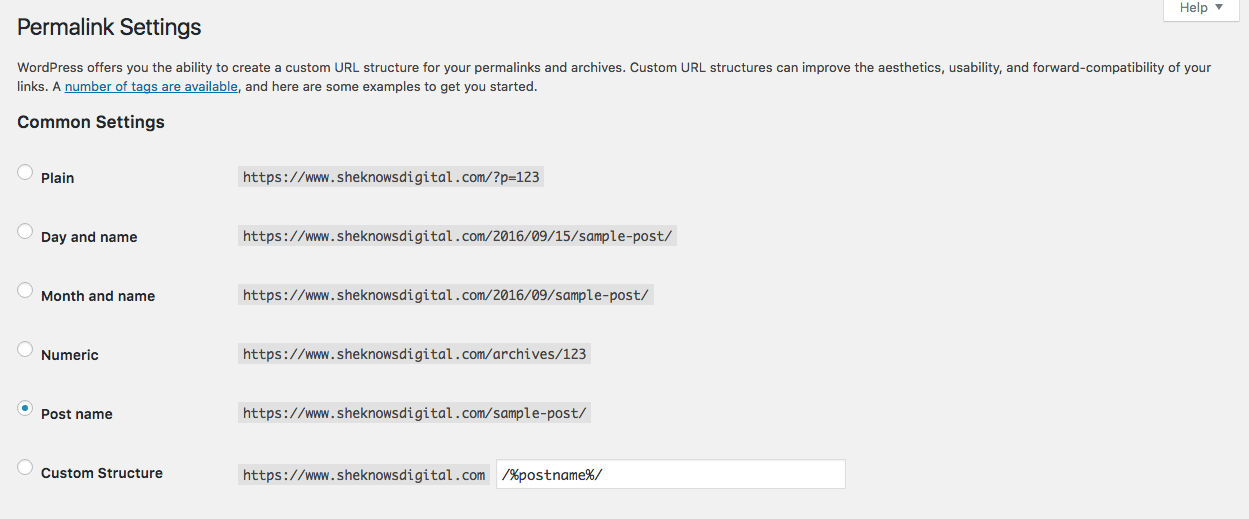When you first install WordPress onto your domain it can be a little tricky to work out what’s what.
You want your new website or blog to succeed but some of the things you do naturally when you first get stuck in could be hurting your site and damaging its SEO.
Below I’m taking a closer look at just 5 WordPress setups which could be damaging your blog and how you can fix them, giving your site a better chance of SEO success.
1. Default Permalinks
When you first setup your WordPress site it automatically provides URLs for your posts which look a little like this: http://yourdomain.com/?p=1. This doesn’t help your SEO and in fact it doesn’t help your readers either. A properly structured URL and permalink will give visitors a clue to what the subject of the post is before they click or read. Default permalinks are not search engine friendly and some of the more accepted, SEO-friendly options look a little like this:
- http://yourdomain.com/category/post-name
- http://yourdomain.com/postname
- http://yourdomain.com/postname/numeric-ID

In all of these instances, your readers and search engines can both look at the link before the text and content on the page and have an understanding of the content before visiting. As long as your categories are not complicated then a category-postname format is fine, but many bloggers opt for the post-name format as its short, sweet and particularly SEO friendly.
2. Disorganised Categories and Tags
As I’ve recently discussed on my dedicated Ultimate Guide to WordPress Categories and Tags, a disordered hierarchy on your blog can confuse both search engines and your readers. Using the same tag and category names can result in duplicate content appearing on your blog. The best way to keep your blog organised is to keep it simple. Keep categories broad, tags more precise and never set up a tag or category which only has one post in it.
3. Untidy Sidebar with Too Many Links
You probably visit many blogs and website which have a sidebar packed with links out for things such as their blogroll. Blogrolls are a great idea as it is a way of sharing the love for others in your particular blogging community or niche, but it can get a little untidy if you pack out your sidebar with them. Instead set up a separate page which can be accessed from your menu.
From an SEO perspective, it is important not to overload your pages and posts with links. Whilst there is no direct guideline Matt Cutts of Google once stated: ‘Keep the links on a given page to a reasonable number (fewer than 100).’ Although Google dropped the 100 links per page guideline, they still may take action if linking looks too spammy. For most regular blogs 100 links will be far too many and it confuses both search engines and your readers, don’t you think?
4. Setting up your Blog on a Subdomain
Although Google said that they keep subdomains and domains as one, many different tests show that in reality, it doesn’t seem to be the case. Different search engines use different metrics and they keep different metrics for domains and subdomains. Therefore, recommended best practice is to keep link-worthy content such as your blog in subfolders, rather than separating them off into subdomains.
For example, it is better for your SEO to have the structure www.yourdomain.com/blog than blog.yourdomain.com.
5. Missing Sitemap
Sitemaps are one of the most straightforward ways of giving search engines a little idea about the structure and organisation of your site. They are a powerful tool for bloggers and website owners as they can actively make the choice to submit their sitemap to search engines. By doing this you are telling your chosen search engines that your site is available for crawling and the sitemap is simply a very straightforward map of all the URLs at your site and the following information about each URL:
- Last update
- Frequency of changes
- Importance of the URL in the hierarchy of your site
If you are a happy owner of a WordPress blog, I strongly recommend the Google XML Sitemaps plugin. I have been using it for almost 9 years and I can honestly say it makes a huge difference to the search presence of my blog!
Conclusion
Choosing WordPress to host your website or blog is a brilliant choice because it is so versatile and easy to use. However, if you don’t set it up correctly your site can soon look cluttered, untidy and send out the wrong signals to search engines. If you want your site to be found and you want your readers to enjoy it, keep these points in mind and you’ll soon achieve the results you’re looking for. Have you recognised any bad habits of yours in this list? Hopefully, now you can get them sorted and get the most out of your WordPress website.
